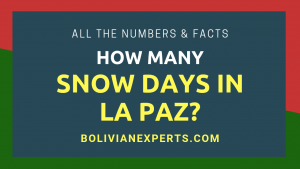The coldest months in La Paz Bolivia are mostly in the middle of the year between fall and winter. In these months, you will see many people wearing thick clothes on both nights and days and also in some cases, it’ll snow. The days will be sunny but cold and also not really moist.
The coldest months in La Paz Bolivia are both June and July, other very cold months are May and August. Most of the time June is the coldest month in the city, and in some cases July. Normally temperatures reach 30°F during the days and 50°F at night in these two months.
Here we will be talking about every detail in regard to the coldest months of the year in La Paz city of Bolivia. You will get all the numbers about the temperatures, and also, some clues about hailing when it occurs in the city. We are citizens of Bolivia.
Which are the coldest months in La Paz Bolivia?
La Paz Bolivia normally gets colder at the end of fall and in the winter. The coldest months are either June or July, but most of the time the coldest month is June. You should expect temperatures to go down from May to reach the lowest point at the end of June or the beginning of July and start rising again in August.
So, in summary:
- It gets colder in May.
- Most of the time, June is the coldest month in its last weeks.
- Sometimes, July is the coldest month in its first weeks.
- August is still cold, but less cold than previous months.
You will find the coldest time of the year in La Paz Bolivia between the last weeks of June and the first weeks of July. Officially, 21st June has been declared as the coldest day in the city, but this normally doesn’t match.
How cold are the days during these months?
In La Paz, the coldest months have the following temperatures:
- May, when it starts to get colder, 55°F in the days and 35°F at night.
- June, most of the time, the coldest month of the year, 50°F in the days and 30°F at night.
- July, is sometimes the coldest month of the year, 50°F in the days and 30°F at night.
- August, it starts to get warmer, 60°F in the days and 40°F at night.
In these months, you should expect all the people living in the city to wear quite thick clothing, with several layers of clothes. Especially in June and July as we say before. In this season, nights in some cases will reach freezing levels, and sometimes it will also snow.
Other climate aspects in the coldest months of La Paz city
Between May and August, the coldest months of La Paz, you should expect almost only sunny days without any clouds over the sky. The air will also be dry and the winds will be cold, but in August they will become turbulent on some days, reaching velocities of around 30 miles per hour. It will also snow between 3 to 10 days of these months, mostly at night.
There is little snow in La Paz Bolivia, but sometimes hail can be dangerous, because of its severity and sudden appearance. These hail storms don’t happen in winter, or in the coldest months, instead, they happen in summer.
We have a complete guide about how many days it snows in La Paz, with all the details about the average snowing and also hailing in the city, being this last one, by the way, dangerous in some cases, in the following direction: How many days does it snow in La Paz? All you need to know.
Conclusions:
Here you have seen all the detailed information about the coldest months of La Paz Bolivia, which actually are June and July, being June, most of the time, is the coldest month in the city, and its last weeks are the coldest weeks there. Also, May and August are very cold too.
You learned that in these months and weeks, the temperature can average 50°F during the day and 30°F at night. You also have seen that it can snow during this time. You also learned that there is an official coldest day in La Paz city, June 21st, but normally it doesn’t match. Finally, the coldest months are also very sunny and dry.
We hope this information has helped you, and if you want to know every detail about the climate in Bolivia, including the coldest months in other principal cities, visit our definitive guide in the following direction: How is the climate in Bolivia? A complete overview.
BolivianExperts.com, information about how to live, work, invest, and travel in Bolivia.








